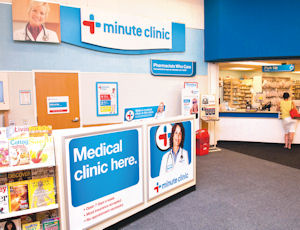MinuteClinic, the retail medical clinic owned by CVS Caremark Corp., recently opened a new store in Sherman Oaks. But following years of rapid expansion, this single store opening calls attention to MinuteClinic’s struggles in Southern California, where ambitious growth plans have largely stalled. MinuteClinic has five San Fernando Valley outlets and 23 in the greater Los Angeles area. CVS shuttered eight to nine MinuteClinics in the Los Angeles area in recent years, including one in Encino and one in Glendale. Of 42 that it opened in the greater Los Angeles area — including those in Riverside and Orange counties — it has closed 19 since 2009, according to Merchant Medicine LLC, a consulting firm that tracks the retail clinic business. Debbie P. Palaski, district manager of operations, admits that cracking the L.A. market has been tough. “It’s been challenging to say the least,” she said. The oldest and largest operator of store-based medical clinics that treat common ailments like strep throat or ear infections, MinuteClinic is also refining its national strategy. It has downsized to 570 stores nationwide from more than 657 at the end of last year as it has sought to clarify what makes a store successful. The division broke even for the first time at the end of 2011, according to company documents. The challenge in California has been the high penetration of managed care, making it difficult for retail clinic operators to attract patients. “In the eyes of the insurance company, they have already paid a doctor to take care of that (patient) under a capitation arrangement,” said Tom Charland, CEO of Merchant Medicine. “Kaiser (Permanente) is very strong in the entire state and they don’t reimburse for MinuteClinic visits.” Another challenge has been seasonality, Charland added. “Retail clinics are highly seasonal, and that makes it a tough business to make money at. If MinuteClinic was making money, CVS would have them in a lot more than 550 of their 7,000 plus stores.” He said many stores have been turned into seasonal operations, open primarily during flu season. Some of those have been shut down. Palaski said understanding what makes a retail clinic successful has taken some trial and error, but that the company is now clear about what works and what clearly does not. “Initially,” Palaski said, “the company threw dice out and where they landed, they popped one in there. Over the years they’ve discovered the formula for what makes a clinic successful.” New store The Sherman Oaks location on Ventura Boulevard fits the profile for a good MinuteClinic location, Palaski said. It’s one of the busiest CVS stores in Los Angeles with high foot traffic — factors that should assure its success, she said. It also will benefit from the West Valley residential demographic, which includes a high number of employed, young professionals and young families with health insurance, Palaski said. MinuteClinic’s Burbank location has many of the same characteristics and it has been successful; the hope is that the new Sherman Oaks location will take some of the load off that store, Palaski said. By contrast, the Reseda store, tucked in a shopping mall at the intersection of Tampa Avenue and Victory Boulevard, has struggled, she said. Patient visits are slow and the MinuteClinic staff sometimes finds itself going up and down the CVS aisles trying to drum up business. Larger, corporate changes should help MinuteClinic going forward, Palaski said. There is now an effort to move MinuteClinic to a primary care model, meaning that its nurse practitioners would provide services for chronic diseases such as diabetes and high blood pressure in addition to episodic treatment for colds and flus. In addition, MinuteClinic is negotiating with the State of California for the possibility of becoming an “in-network” provider of health services with the Medi-Cal or Medicaid program. If successful, it would allow beneficiaries of that system to visit MinuteClinic sites, potentially expanding the number of patients. The company also is negotiating a partnership with a major Los Angeles health system, which would allow MinuteClinic to see patients within that health system. Patients’ electronic medical records would be integrated and accessible, allowing patient referrals and visits to flow easily between MinuteClinic and the health system. The agreement would follow others that MinuteClinic has struck with some 14 health system partners nationwide. Palaski said MinuteClinic is not the “Jack in the Box” medicine that some called it when it first emerged on the scene more than 10 years ago. “We have standards and quality measures and we follow evidence-based medicine,” she said. MinuteClinic is not alone in expanding into primary care. According to the Convenient Care Association — a trade association that represents most of the nation’s 1,350 retail clinics — clinics are expanding their menu of services, moving especially into chronic care management. “The model is still a 15 to 20 minute visit, but you can deliver a good amount of chronic disease management and even wellness care in that time,” said Tine Hansen-Turton, executive director of CCA. After a drop in growth that she attributed to the troubled economy, Hansen-Turton said retail clinics are poised for more growth, regardless of what happens with health care reform. “Retail clinics are the lowest-cost option for any primary care model,” she said. CVS itself has plans to continue to grow stores, with 100 a year planned for the next five years. Back in the Southern California region, the company is only planning one more opening this year — in Temecula. But Palaski said Simi Valley and Santa Clarita may make attractive expansions for 2013. “Now that we know what makes a store successful,” she said, “it will be so much less risky.”
